|
|
| |
|
|
| |
|
|
|
|
| |
 |
| Blue light is
scattered more than other wavelengths by the
gases in the atmosphere, surrounding Earth in a
visibly blue layer when seen from space on board
the ISS at an altitude of 335 km (208 mi). |
Atmosphere
The atmosphere of Earth is the layer of gases, commonly
known as air, retained by Earth's gravity, surrounding
the planet Earth and forming its planetary atmosphere.
The atmosphere of Earth protects life on Earth by
creating pressure allowing for liquid water to exist on
the Earth's surface, absorbing ultraviolet solar
radiation, warming the surface through heat retention
(greenhouse effect), and reducing temperature extremes
between day and night (the diurnal temperature
variation).
By volume, dry air contains 78.09% nitrogen, 20.95%
oxygen, 0.93% argon, 0.04% carbon dioxide, and small
amounts of other gases. Air also contains a variable
amount of water vapor, on average around 1% at sea
level, and 0.4% over the entire atmosphere. Air
composition, temperature, and atmospheric pressure vary
with altitude, and air suitable for use in
photosynthesis by terrestrial plants and breathing of
terrestrial animals is found only in Earth's troposphere
and in artificial atmospheres.
Earth's atmosphere has changed much since its formation
as primarily a hydrogen atmosphere, and has changed
dramatically on several occasions—for example, the Great
Oxidation Event 2.4 billion years ago, greatly increased
oxygen in the atmosphere from practically no oxygen to
levels closer to present day. Humans have also
contributed to significant changes in atmospheric
composition through air pollution, especially since
industrialisation, leading to rapid environmental change
such as ozone depletion and global warming. |
|
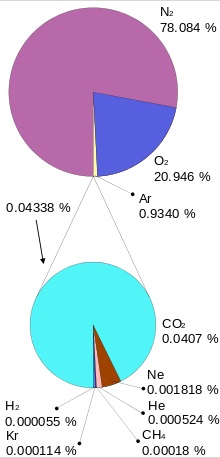 |
| Composition of
Earth's atmosphere by volume, excluding water
vapor. Lower pie represents trace gases that
together compose about 0.043391% of the
atmosphere (0.04402961% at April 2019
concentration). Numbers are mainly from 2000,
with CO2 and methane from 2019, and do not
represent any single source. |
Composition
The three major constituents of Earth's atmosphere are
nitrogen, oxygen, and argon. Water vapor accounts for
roughly 0.25% of the atmosphere by mass. The
concentration of water vapor (a greenhouse gas) varies
significantly from around 10 ppm by volume in the
coldest portions of the atmosphere to as much as 5% by
volume in hot, humid air masses, and concentrations of
other atmospheric gases are typically quoted in terms of
dry air (without water vapor). The remaining gases are
often referred to as trace gases, among which are the
greenhouse gases, principally carbon dioxide, methane,
nitrous oxide, and ozone. Besides argon, already
mentioned, other noble gases, neon, helium, krypton, and
xenon are also present. Filtered air includes trace
amounts of many other chemical compounds. Many
substances of natural origin may be present in locally
and seasonally variable small amounts as aerosols in an
unfiltered air sample, including dust of mineral and
organic composition, pollen and spores, sea spray, and
volcanic ash. Various industrial pollutants also may be
present as gases or aerosols, such as chlorine
(elemental or in compounds), fluorine compounds and
elemental mercury vapor. Sulfur compounds such as
hydrogen sulfide and sulfur dioxide (SO2) may be derived
from natural sources or from industrial air pollution. |
|
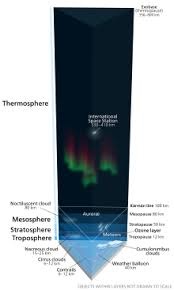 |
| Earth's atmosphere
Lower 4 layers of the atmosphere in 3 dimensions
as seen diagonally from above the exobase.
Layers drawn to scale, objects within the layers
are not to scale. Aurorae shown here at the
bottom of the thermosphere can actually form at
any altitude in this atmospheric layer. |
Stratification
In general, air pressure and density decrease with
altitude in the atmosphere. However, the temperature has
a more complicated profile with altitude, and may remain
relatively constant or even increase with altitude in
some regions (see the temperature section, below).
Because the general pattern of the temperature/altitude
profile, or lapse rate, is constant and measurable by
means of instrumented balloon soundings, the temperature
behavior provides a useful metric to distinguish
atmospheric layers. In this way, Earth's atmosphere can
be divided (called atmospheric stratification) into five
main layers. Excluding the exosphere, the atmosphere has
four primary layers, which are the troposphere,
stratosphere, mesosphere, and thermosphere. From highest
to lowest, the five main layers are:
|
- Exosphere: 700 to 10,000 km (440
to 6,200 miles)
- Thermosphere: 80 to 700 km (50
to 440 miles)
- Mesosphere: 50 to 80 km (31 to
50 miles)
- Stratosphere: 12 to 50 km (7 to
31 miles)
- Troposphere: 0 to 12 km (0 to 7
miles)
|
|
Air pollution
Air pollution is the introduction into the atmosphere of
chemicals, particulate matter or biological materials
that cause harm or discomfort to organisms.
Stratospheric ozone depletion is caused by air
pollution, chiefly from chlorofluorocarbons and other
ozone-depleting substances.
The scientific consensus is that the anthropogenic
greenhouse gases currently accumulating in the
atmosphere are the main cause of climate change. |
|
|
 Kiddle:
Atmosphere of Earth Kiddle:
Atmosphere of Earth
Wikipedia: Atmosphere of Earth |
|
|
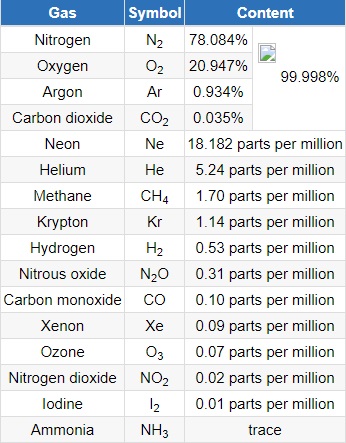 |
| Chemical makeup of
the atmosphere EXCLUDING water vapor. |
The Atmosphere
The atmosphere is a cloud of gas and suspended solids
extending from the Earth's surface out many thousands of
miles, becoming increasingly thinner with distance but
always held by the Earth's gravitational pull.
The atmosphere surrounds the Earth and holds the air we
breathe; it protects us from outer space; and holds
moisture (clouds), gases, and tiny particles. In short,
the atmosphere is the protective bubble in which we
live.
This protective bubble consists of several gases (listed
in the table to the right) with the top four making up
99.998% of all gases. Of the dry composition of the
atmosphere nitrogen, by far, is the most common.
Nitrogen dilutes oxygen and prevents rapid burning at
the Earth's surface. Living things need it to make
proteins.
Oxygen is used by all living things and is essential for
respiration. It is also necessary for combustion or
burning.
Argon is used in light bulbs, in double-pane windows,
and used to preserve the original Declaration of
Independence and the Constitution. Plants use carbon
dioxide to make oxygen. Carbon dioxide also acts as a
blanket that prevents the escape of heat into outer
space. |
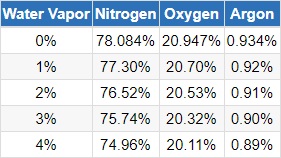 |
| Chemical makeup of
the atmosphere INCLUDING water vapor. |
These percentages of atmospheric gases are
for a completely dry atmosphere. The atmosphere is
rarely, if ever, dry. Water vapor (water in a 'gas'
state) is nearly always present up to about 4% of the
total volume.
In the Earth's desert regions (30°N/S) when dry winds
are blowing, the water vapor contribution to the
composition of the atmosphere will be near zero.
Water vapor contribution climbs to near 3% on extremely
hot/humid days. The upper limit, approaching 4%, is
found in tropical climates. The table (left) shows the
changes in atmospheric composition with the inclusion of
different amounts of water vapor.
Layers of the Atmosphere
The envelope of gas surrounding the Earth changes from
the ground up. Five distinct layers have been identified
using... |
- thermal characteristics (temperature changes),
- chemical composition,
- movement, and
- density.
|
 |
| The five basic
layers of the atmosphere. |
Each of the layers are bounded by "pauses" where the
greatest changes in thermal characteristics, chemical
composition, movement, and density occur.
Exosphere
This is the outermost layer of the atmosphere. It
extends from the top of the thermosphere to 6,200 miles
(10,000 km) above the earth. In this layer, atoms and
molecules escape into space and satellites orbit the
earth. At the bottom of the exosphere is the thermopause
located around 375 miles (600 km) above the earth.
Thermosphere
Between about 53 miles (85 km) and 375 miles (600 km)
lies the thermosphere. This layer is known as the upper
atmosphere. While still extremely thin, the gases of the
thermosphere become increasingly denser as one descends
toward the earth.
As such, incoming high energy ultraviolet and x-ray
radiation from the sun begins to be absorbed by the
molecules in this layer and causes a large temperature
increase.
Because of this absorption, the temperature increases
with height. From as low as -184°F (-120°C) at the
bottom of this layer, temperatures can reach as high as
3,600°F (2,000°C) near the top.
However, despite the high temperature, this layer of the
atmosphere would still feel very cold to our skin due to
the very thin atmosphere. The high temperature indicates
the amount of the energy absorbed by the molecules but
with so few in this layer, the total number of molecules
is not enough to heat our skin. |
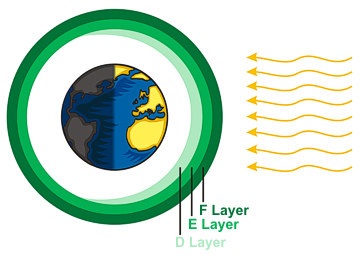 |
| The three main
layers of the ionosphere labeled D, E and F. |
This absorption of radiation is also
responsible for the ionosphere. Located within the
thermosphere, the ionosphere is made of electrically
charged gas particles (ionized).
The ionosphere extends from 37 to 190 miles (60-300 km)
above the earth's surface. It is divided into three
regions or layers; the F-Region, E-Layer and D-Layer.
During the daytime the F-Layer splits into two layers
then recombines at night.
The E-Layer was discovered first. In 1901, Guglielmo
Marconi transmitted a signal between Europe and North
America and showed that it had to bounce off an
electrically conducting layer about 62 miles (100 km)
altitude. In 1927, Sir Edward Appleton named that
conducting layer the (E)lectrical-Layer. Additional
conducting layers discovered later were simply called
the D-Layer and F-Layer.
Since the ionosphere's existence is due to radiation
from the sun striking the atmosphere, it changes in
density from daytime to nighttime. All three layers are
more dense during the daytime. At night, all layers
decrease in density with the D-Layer undergoing the
greatest change. At night the D-Layer essentially
disappears.
As seen around the 1900's, the ionosphere has the
important quality of bouncing radio signals transmitted
from the earth. Its existence is why places all over the
world can be reached via radio. |
|
Transmissions from radio stations can bounce
between the earth's surface and the ionosphere many
times. As the radio signal is transmitted, some of the
signal will escape the earth through the ionosphere
(green arrow). The ground wave (purple arrow) is the
direct signal we hear on a normal basis. This wave
weakens quickly and is what one hears as a fading
signal. The remaining waves (red and blue arrows) are
called "skywaves." These waves bounce off the ionosphere
and can bounce for many 1000's of miles depending upon
the atmospheric conditions. |
Mesosphere
This layer extends from around 31 miles (50 km) above
the Earth's surface to 53 miles (85 km). The gases,
including the oxygen molecules, continue to become
denser as one descends. As such, temperatures increase
as one descends rising to about 5°F (-15°C) near the
bottom of this layer.
The gases in the mesosphere are now thick enough to slow
down meteors hurtling into the atmosphere, where they
burn up, leaving fiery trails in the night sky. Both the
stratosphere (next layer down) and the mesosphere are
considered the middle atmosphere. The transition
boundary which separates the mesosphere from the
stratosphere is called the stratopause. |
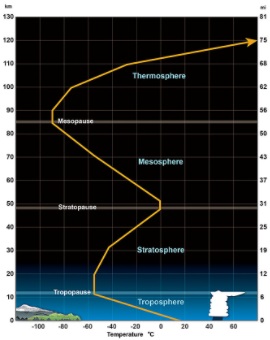 |
| Average temperature
profile for the lower layers of the atmosphere. |
Stratosphere
The Stratosphere extends around 31 miles (50 km) down to
anywhere from 4 to 12 miles (6 to 20 km) above the
Earth's surface. This layer holds 19 percent of the
atmosphere's gases but very little water vapor.
In this region the temperature increases with height.
Heat is produced in the process of the formation of
Ozone and this heat is responsible for temperature
increases from an average -60°F (-51°C) at tropopause to
a maximum of about 5°F (-15°C) at the top of the
stratosphere.
This increase in temperature with height means warmer
air is located above cooler air. This prevents
"convection" as there is no upward vertical movement of
the gases. As such the location of the bottom of this
layer is readily seen by the 'anvil-shaped' tops of
cumulonimbus clouds.
Troposphere
Known as the lower atmosphere almost all weather occurs
in this region. The troposphere begins at the Earth's
surface and extends from 4 to 12 miles (6 to 20 km)
high.
The height of the troposphere varies from the equator to
the poles. At the equator it is around 11-12 miles
(18-20 km) high, at 50°N and 50°S, 5½ miles and at the
poles just under four miles high.
As the density of the gases in this layer decrease with
height, the air becomes thinner. Therefore, the
temperature in the troposphere also decreases with
height in response. As one climbs higher, the
temperature drops from an average around 62°F (17°C) to
-60°F (-51°C) at the tropopause. |
|
|
|
|
|
|
|
|
|
|
|
|
|
|
|
|
|
|
Search Fun Easy English |
|
|
|
|
|
|
|
|
|
|
|
|
|
|
|
About
Contact
Copyright
Resources
Site Map |